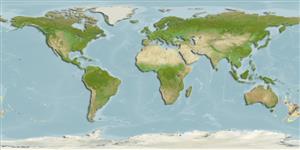Élasmobranches (requins et raies) (sharks and rays) >
Squaliformes (Sleeper and dogfish sharks) >
Squalidae (Dogfish sharks)
Etymology: Squalus: Genus name from Latin 'squalus' meaning shark (Ref. 6885, 27436); chloroculus: Name from Greek 'choloros' for green and Latin 'oculus' for eye, referring to the vivid green eyes of this species when fresh..
More on authors: Last, White & Motomura.
Environment: milieu / climate zone / depth range / distribution range
Écologie
marin bathydémersal; profondeur 213 - 1360 m (Ref. 58441). Deep-water
Western Pacific: Australia.
Length at first maturity / Taille / Poids / Âge
Maturity: Lm 79.9 range ? - ? cm
Max length : 85.6 cm TL mâle / non sexé; (Ref. 58441); 99.0 cm TL (female)
Description synthétique
Morphologie | Morphométrie
This species of the ‘mitsukurii group’ is large and is distinguished by the following set of characters: body moderately robust, trunk depth 10.4-13.8% TL (mean 11.7% TL, n=9); snout is broadly triangular, with mouth width 1.72-2.48 (2.07) times the horizontal prenarial length; pre-first dorsal length 29.2-31.8 (30.2)% TL; pre-second dorsal length 60.7-63.6 (61.7)% TL; interdorsal space 23.7-27.5 (24.9)% TL; low raked dorsal fins; second dorsal-fin length 10.9-12.2 (11.6)% TL, height 3.4-4.0 (3.7)% TL, inner margin length 3.9-5.0 (4.4)% TL; second dorsal-fin base 15.1-20.0 (17.2) times the base of second dorsal spine; pre-pectoral length 21.1-24.3 (22.2)% TL; pelvic-caudal space 21.8-25.0 (23.5)% TL; caudal bar is almost upright, extending broadly from the caudal fork up the poster or margin of the upper lobe for 0.6-0.7 of its length in immature individuals, upper caudal fringe forming a narrow saddle along midlength of lobe; flank denticles tricuspid; monospondylous centra 43-46, precaudal centra 84-86, total centra 111-115 (Ref. 58441).
Distinct pairing with embrace (Ref. 205).
Last, P.R., W.T. White and H. Motomura, 2007. Description of Squalus chloroculus sp. nov., a new spurdog from southern Australia, and the resurrection of S. montalbani Whitley. p. 55-69. In P.R. Last, W.T. White and J.J. Pogonoski Descriptions of new dogfishes of the genus Squalus (Squaloidea:Squalidae). CSIRO Marine and Atmospheric Research Paper No. 014. 130 p. (Ref. 58441)
Statut dans la liste rouge de l'IUCN (Ref. 130435)
Menace pour l'homme
Harmless
Utilisations par l'homme
Plus d'informations
PaysZones FAOÉcosystèmesOccurrencesIntroductionsStocksÉcologieRégime alimentaireÉléments du régime alimentaireConsommation alimentaireRation
Taille/ÂgeCroissanceLongueur-poidsLongueur-longueurFréquences de longueursMorphométrieMorphologieLarvesDynamique des populations larvairesRecrutementAbondanceBRUVS
RéférencesAquacultureProfil d'aquacultureSouchesGénétiqueElectrophoresesHéritabilitéPathologiesTraitementNutrientsMass conversion
CollaborateursImagesStamps, Coins Misc.SonsCiguateraVitesseType de nageSurface branchialeOtolithesCerveauxVision
Outils
Articles particuliers
Télécharger en XML
Sources Internet
Estimates based on models
Preferred temperature (Ref.
123201): 5.9 - 11.4, mean 8.5 °C (based on 45 cells).
Phylogenetic diversity index (Ref.
82804): PD
50 = 0.5000 [Uniqueness, from 0.5 = low to 2.0 = high].
Bayesian length-weight: a=0.00339 (0.00162 - 0.00707), b=3.10 (2.93 - 3.27), in cm total length, based on LWR estimates for this Genus-body shape (Ref.
93245).
Niveau trophique (Ref.
69278): 4.4 ±0.4 se; based on size and trophs of closest relatives
Résilience (Ref.
120179): Très faible, temps minimum de doublement de population supérieur à 14 ans (Fec=4-15).
Fishing Vulnerability (Ref.
59153): High vulnerability (60 of 100).
